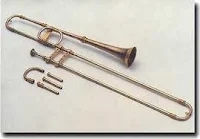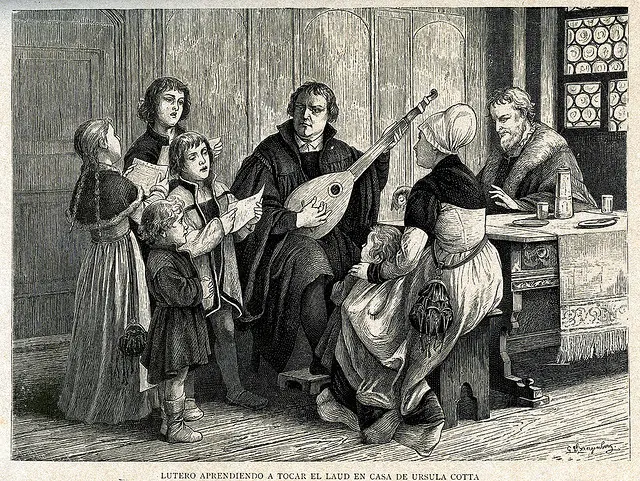Trabajo sobre la película "Lutero" del director Eric Till vista en clase.
1.- Busca en la red las "95 Tesis" y elige una para comentar.
2.- Investiga: ¿qué fueron los autos sacramentales?
3.- Acompañando el auto sacramental aparecen tres instrumentos. Descríbelos y di de qué instrumentos son predecesores.
4.- Busca información sobre Lucas Cranach, sobre qué eran las reliquias, qué las indulgencias.
5.- Relaciona los tres Papas citados en el film con estos nombres: Borgia - Miguel Ángel Buonarotti - Henry VIII Tudor.
6.- Carlos I de Austria aparece como emperador en la Dieta de Worms. Coteja datos acerca de la fecha en que se hace emperador a Carlos y la fecha de la muerte del Papa León X.
7.- En la película se hace referencia a los abuelos de Carlos I de Austria. Haz un gráfico genealógico con sus abuelos maternos y paternos.
8.- En la escena correspondiente, antes de la Dieta de Augsburgo aparecen los feligreses cantando un coral luterano. Describe la textura, el ritmo y cualquier otra característica que consideres destacable. Escucha desde el minuto 2'42.
9.- Lee acerca del toisón de oro, que aparece al tercer minuto de la segunda hora de la película, y el porqué Carlos I llegó a ser el gran maestre de esta orden borgoñona; y de la rosa de oro.
10.- Según el orden de lista del curso, traduce las frases que te correspondan. Si eres el 15º, comienza con la 1ª.
Gracias a esta película hemos aprendido muchas cosas, sin embargo, tiene detalles inexactos.
En la red he encontrado una lista de ellos, en la wikipedia y aquí: http://secondscreenings.wordpress.com/film-essays/lutheran-but-not-luther/.
¡Adelante, a practicar tu inglés!
Inaccuracies: 1.-Luther and his ruler, Frederick the Wise, never met; Pope Leo X died well before 1525; 2.-Luther did not nail the 95 theses on the door of the Wittenberg castle church but sent them to Archbishop Albert; Frederick did not pay Luther’s salary; 3.-worshipers did not sit in pews in the early 16th century; Luther did not come to Wittenberg as a parish priest; 4.-Carlstadt never advocated political egalitarianism; Luther returned to a tumultuous Wittenberg not at Elector Frederick’s behest but very much (and quite courageously so) against the ruler’s will.
One wishes also to have been spared such modernizing anachronisms as Luther’s saying, “Thanks for coming to mass” as worshipers leave church, and “We will play joyous music together” to Katie.
5.-In the film, Luther refers to Bible passages by the book, chapter, and verse. However, the Bible was not divided into verses until 1551, and even then the divisions were not ubiquitous until the Geneva Bible. (It can be assumed that this was done in order that discerning viewers might easily locate the text to which Luther refers.) 6.- Albert of Mainz is described as being archbishop of two German territories before acquiring Mainz. In real life, he was Prince-Archbishop of Magdeburg and Prince-Bishop of Halberstadt prior to gaining Mainz. 7.-Luther is shown hammering his 95 Theses to the doors of Castle Church in Wittenberg, which are immediately read by by-standers, taken and printed. In reality, the common people would not have been able to read the theses, which were originally written in Latin, but were translated into German and spread throughout Europe within two months. 8.-During the Augsburg Confession scene, all of the nobles, including the elector princes, stood up to Charles V. In real life, most of the princes were still Catholic. Only one (or maybe two) of the seven electors should have made a stand, the Duke of Saxony and the somewhat conciliant Louis V, Elector Palatine. Three other electors were Catholic archbishops, e.g. Albert of Mainz, and two more secular electors sided with the Catholics, the King of Bohemia, Charles' brother Ferdinand, and Joachim Nestor of Brandenburg, Albert's brother.9.- The film stated that Luther and Spalatin went to law school together. In reality, they did not meet until much later. The film implies that Frederick of Saxony is given the Golden Rose as a bribe: to coerce him into delivering Luther to Rome. In real life, he was awarded the rose before, most likely to make him run for emperorship against Charles. 10.-Alexander addresses Cajetan as cardinal in his first appearance, which apparently takes place shortly after the papal conclave that elected Leo X in 1513. In reality, Cajetan did not become a cardinal until four years later. 11.-The film makes only brief mention of Luther's problems with constipation during his time at Wartburg (he makes a brief reference to the fact that porridge will do little to help his bowels). In reality, Luther suffered greatly from this, and other aliments. Andreas Karlstadt is herein depicted as radically distorting Luther's views while Luther is in seclusion at Wartburg, insisting on being addressed as "Brother Andreas." Though the reforms which were actually orchestrated by Karlstadt were more peaceful, they were too radical for Luther (including vernacularization of the Mass), and Luther began to undo or slow them. 12.-Karlstadt also did not renounce his title of professor until after Luther's return. In the film, Luther returns to visit Wittenberg incognito (at the urging of George Spalatin) with a modest growth of beard and under the title "Knight George." Luther actually had grown a beard "sufficient to deceive his mother" and under the name "Junker George," which means "Knight George" [Roland H. Bainton, "Here I Stand", pp. 194, 205] 13.-Shortly before Prince Frederick convinces Charles to give Luther a hearing at the Diet of Worms, the Emperor introduces Aleander to him as a "new cardinal" and Aleander's dress supports this. Aleander would in fact not become a cardinal for another 15 years.14.- Pope Alexander VI is said to have had five children. In real life he had more than that.
One wishes also to have been spared such modernizing anachronisms as Luther’s saying, “Thanks for coming to mass” as worshipers leave church, and “We will play joyous music together” to Katie.
5.-In the film, Luther refers to Bible passages by the book, chapter, and verse. However, the Bible was not divided into verses until 1551, and even then the divisions were not ubiquitous until the Geneva Bible. (It can be assumed that this was done in order that discerning viewers might easily locate the text to which Luther refers.) 6.- Albert of Mainz is described as being archbishop of two German territories before acquiring Mainz. In real life, he was Prince-Archbishop of Magdeburg and Prince-Bishop of Halberstadt prior to gaining Mainz. 7.-Luther is shown hammering his 95 Theses to the doors of Castle Church in Wittenberg, which are immediately read by by-standers, taken and printed. In reality, the common people would not have been able to read the theses, which were originally written in Latin, but were translated into German and spread throughout Europe within two months. 8.-During the Augsburg Confession scene, all of the nobles, including the elector princes, stood up to Charles V. In real life, most of the princes were still Catholic. Only one (or maybe two) of the seven electors should have made a stand, the Duke of Saxony and the somewhat conciliant Louis V, Elector Palatine. Three other electors were Catholic archbishops, e.g. Albert of Mainz, and two more secular electors sided with the Catholics, the King of Bohemia, Charles' brother Ferdinand, and Joachim Nestor of Brandenburg, Albert's brother.9.- The film stated that Luther and Spalatin went to law school together. In reality, they did not meet until much later. The film implies that Frederick of Saxony is given the Golden Rose as a bribe: to coerce him into delivering Luther to Rome. In real life, he was awarded the rose before, most likely to make him run for emperorship against Charles. 10.-Alexander addresses Cajetan as cardinal in his first appearance, which apparently takes place shortly after the papal conclave that elected Leo X in 1513. In reality, Cajetan did not become a cardinal until four years later. 11.-The film makes only brief mention of Luther's problems with constipation during his time at Wartburg (he makes a brief reference to the fact that porridge will do little to help his bowels). In reality, Luther suffered greatly from this, and other aliments. Andreas Karlstadt is herein depicted as radically distorting Luther's views while Luther is in seclusion at Wartburg, insisting on being addressed as "Brother Andreas." Though the reforms which were actually orchestrated by Karlstadt were more peaceful, they were too radical for Luther (including vernacularization of the Mass), and Luther began to undo or slow them. 12.-Karlstadt also did not renounce his title of professor until after Luther's return. In the film, Luther returns to visit Wittenberg incognito (at the urging of George Spalatin) with a modest growth of beard and under the title "Knight George." Luther actually had grown a beard "sufficient to deceive his mother" and under the name "Junker George," which means "Knight George" [Roland H. Bainton, "Here I Stand", pp. 194, 205] 13.-Shortly before Prince Frederick convinces Charles to give Luther a hearing at the Diet of Worms, the Emperor introduces Aleander to him as a "new cardinal" and Aleander's dress supports this. Aleander would in fact not become a cardinal for another 15 years.14.- Pope Alexander VI is said to have had five children. In real life he had more than that.












No hay comentarios:
Publicar un comentario